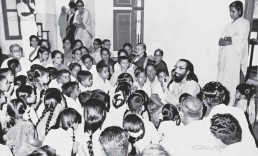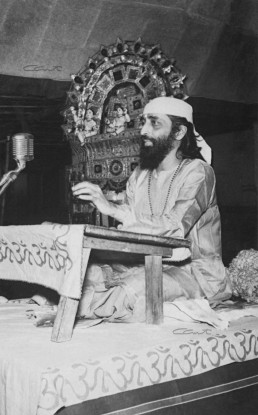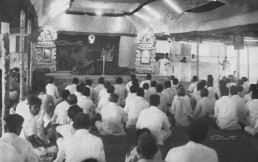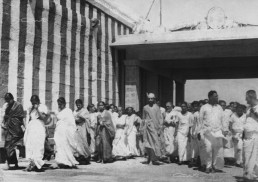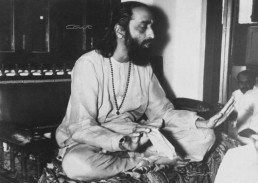
Jnana Yajna 59

Year & Dates:
July 01, 1959 to July 20, 1959

Yajna Topic:
Kenopanishad

Place:
Trichy (Tiruchirappalli), India.
Sanctified by temples like the Sri Ranganatha temple, the Jambukeshwara temple, the Ucchi Pillayar temple, and bathed by the holy Kaveri river, Tiruchirappalli is a place of historic, cultural, and religious significance. To reinvigorate the spiritual quest of those who already had a foothold in Sanatana Dharma, Pujya Gurudev chose Kenopanishad as the subject of contemplation during His 59th Jnana Yajna. A prominent Upanishad from the musical Sama Veda, it holds the revelations of a realized seer for a probing group of seekers. To launch the intense journey to the supreme essence, Dr. C.P. Ramaswami Iyer, erstwhile Diwan of Travancore and a scholarly lawyer inaugurated the Upanishad Jnana Yajna on July 1, 1959. The auspicious beginning was presided by Dr. T.M.Narayanasamy Pillai, Vice-Chancellor, Annamalai University. Within the large pandal in the Thillai Nagar yajnashala, the huge congregation was ready for spiritual lift-off.
A Living Symbol of Veda Vyasa
The 38 verses of Kenopanishad presented in four distinct chapters speak to seekers at different levels of spiritual sadhana. At the very outset, the all-pervasive Brahman illuminating all senses and yet beyond is revealed. In the second chapter, during the sublime exchange with the astute Teacher, the sincere student declares poetically and with great humility about the Truth Inexpressible admitting, “Not that I do not know; I know, and I do not know.” Thoughtful as the Guru is about the category of students who need a visual reinforcement, Chapters 3 and 4 of Kenopanishad are explained through an interesting story; a Yaksha (a mysterious spirit) challenges the Gods who forgot to credit the omnipotent Brahman for their victory over the asuras. When Agni, Vayu, and Indra are defeated by the Yaksha, Goddess Uma gives the knowledge of Brahman.
Methodically, explaining each verse word by word in an easy language rich with His wit and amazing clarity, Pujya Gurudev made the ancient, difficult Kenopanishad truly contemporary and relevant in its perspective. For the upanishadic thought to gain strength, He ensured that the three-pronged preparation of Japa, Upasana, and Karma are integrated in the seekers’ lives. Hence, the Japa that he led in each session, the Laksha Archana to Bhagavan Krishna that he arranged on July 12, 1959, and the purifying act of the yatra and Avabhruta snanam that he included made Pujya Gurudev’s Jnana Yajnas a multifaceted spiritual reorientation.
The place of pilgrimage in the 59th yajna was Palani, the worshipful abode of Lord Karthikeya. On July 18th, a vibrant group of 300 devotees in six buses and a convoy of cars followed Pujya Gurudev for the Avabhruta Snanam in the river Amaravati and darshan of Lord Muruga.
July 20, 1959, which was also Guru Purnima, marked the end of another momentous yajna. Thousands offered their pranams to a Guru extraordinaire in the lineage of Veda Vyasa, with hearts full of gratitude and some sadness to leave the yajnashala that had been their haven of bliss for three weeks.
Photo Gallery
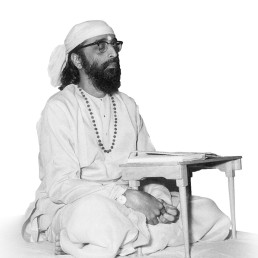
“Think,” Says Pujya Gurudev
Questions as asked by the disciple in Kenopanishad, “What projects the mind out? What orders the mind to go to its objects?”, will not come to the mind of an individual who has not spent many years of intelligent analytical thinking. Unless he has vitally lived the life himself, such questions shall not mean anything to him. Here the seeker has, it is clear, come to a conclusion that the physical eyes cannot see of their own accord. There must be a very subtle power behind the eye-instrument that vitalizes it. And that Power is so subtle that our gross intellect cannot reach anywhere near it. It is something like the instruments used in miniature carving. The work calls for the finer instincts in man, a delicate touch, and intricate movements of the hand etc. and in addition to these it needs finer instruments for the engraving. Similarly, we need a very pure mind-and-intellect-instrument to delve into the depths of the Truth behind the sense organs.
From Kenopanishad Yajna Prasad
Now what is a river? The river is not a mere column of water between two banks. It is not water stagnant within bunds. The essence of a river is in the incessant flow of water from its source to its end. Similarly, the mind is in the unceasing flow of our thoughts. Thoughts are the manifestations of the mind. When thoughts are “flowing” at a great speed, one following the other unceasingly, that flow of thought is called the “Mind”. If you can stop that flow there is no more the mind.
Again, take the illustration of a lighted Agarbathi (Jaw-stick) turning in your hand. One gets the illusion of a golden, effulgent ring, but in reality the circle of rings has no existence apart from the whirling movement of the glowing Agarbathi. Stop the movement and there is no more the golden circle!
From Kenopanishad Yajna Prasad
Is Shri Adi Shankaracharya’s Philosophy Right?
This excerpt explores the philosophical debates on immortality and consciousness, challenging conventional beliefs and delving into the possibility of transcending mortality. Analyze teachings of Shankaracharya and the Upanishads from a rational standpoint to unravel the intriguing question of immortality.

